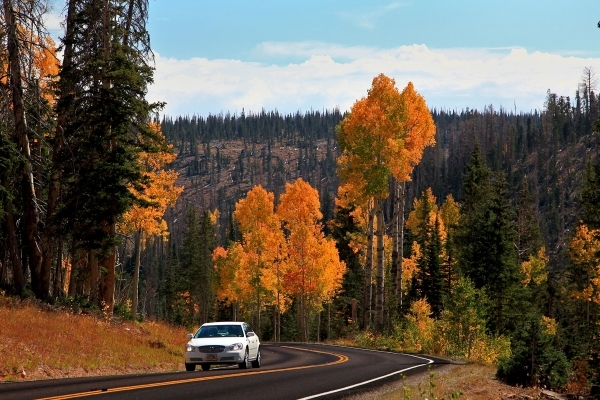Utah byway promises colorful scenery, history

One of Southern Utah’s most scenic byways connects the pioneer communities of Parowan and Panguitch over one of the highest routes in the state, gaining 4,500 feet in elevation. State Route 143 is known as the “Brian Head to Panguitch Lake Scenic Byway,” as well as the “Patchwork Parkway,” for its notably colorful scenery and its connection to a pioneer incident known as the Quilt Walk.
The 51-mile route promises summer flowers, colorful autumn scenery, and Christmas card scenes in winter, when road closures and chain requirements are likely.
To reach the area, follow Interstate 15 north into Utah, exiting onto Route 143 toward Parowan about 20 miles north of Cedar City. Settled by Mormon pioneers in 1851, Parowan is a lovely town that retains many original buildings, giving it 19th-century charm. From Main Street, head south to follow a steep canyon with red and white cliffs onto the 10,000-foot Markagunt Plateau. The road passes the town of Brian Head and the Brian Head ski area as it climbs toward Cedar Breaks National Monument.
The route passes Brian Head Peak, the highest point on the plateau at 11,315 feet. Take time to follow the 3-mile graded road toward the peak. From a parking area, a short trail leads to a roofed lookout pavilion. Views from this site are extraordinary, especially in the fall, when the patchwork of brilliant colors of aspens and other foliage spreads out over hundreds of square miles of Utah, Nevada and northern Arizona.
Just south of the peak, Route 143 parallels the northern edge of the Cedar Breaks boundary and then heads northeast toward Panguitch Lake and the town of Panguitch. A junction marks the turnoff onto state Route 148, the short, scenic connection through Cedar Breaks to state Route 14. A $5 entrance fee applies. The scenery along this byway is always spectacular, but autumn color enhances the experience. Cedar Breaks is closed in winter, usually by late October.
Route 143 begins a long descent from the highest part of the plateau near Cedar Breaks through flower-strewn meadows, evergreen forests and stands of stately quaking aspen in Dixie National Forest. Because of certain soil elements in this area, many aspens turn orange and red in the fall, as well as yellow. Their colors contrast brilliantly against the evergreens and blue autumn skies.
The highway skirts the southern and eastern shores of Panguitch Lake, popular for fishing, boating and camping in summer and for ice fishing, snowmobiling and cross-country skiing in winter. Lakeside resorts rent cabins and boats and provide visitor services seasonally. The highway follows Panguitch Creek from the lake through a canyon it has carved to the town of Panguitch along U.S. Highway 89. Autumn color in this canyon is beautiful and tends to last later in the season.
Nearby Parowan was settled by Mormons who were soon called upon by church leadership to establish other towns in the region. In 1864, a group of families headed over the high plateau to start the town of Panguitch in a well-watered valley on the other side. They had not anticipated the effects that the cold and higher altitude would have on their crops. By winter they were starving and sick.
Several men headed for Parowan to seek help, but their wagon was soon stuck in deep snow. The men knelt for prayer on patchwork quilts laid atop the snow before continuing on foot. They found that the quilts kept them from sinking into the snowdrifts. They continued on their journey by walking on the quilts until they were finally free of the snowdrifts near Parowan. They soon returned to Panguitch with help.
Today the journey is celebrated with an annual Quilt Walk Festival in Panguitch.
Margo Bartlett Pesek’s Trip of the Week column appears on Sundays.